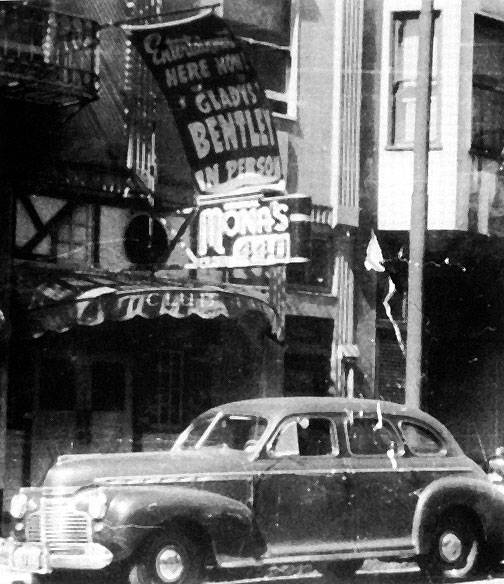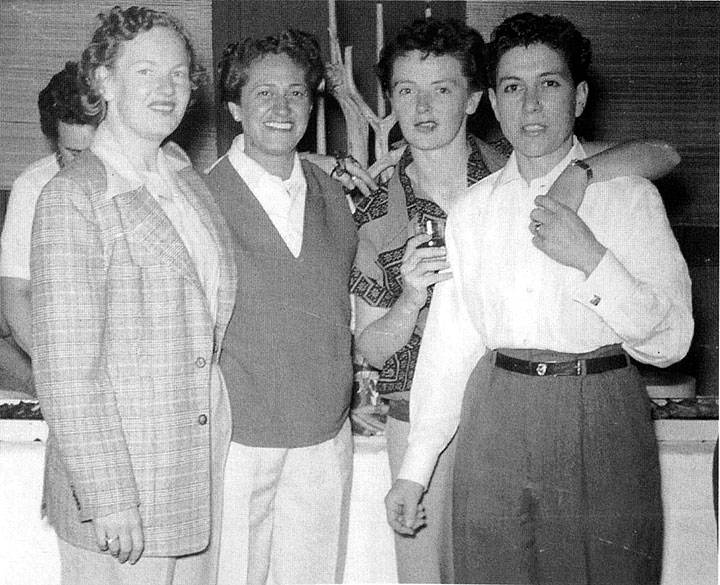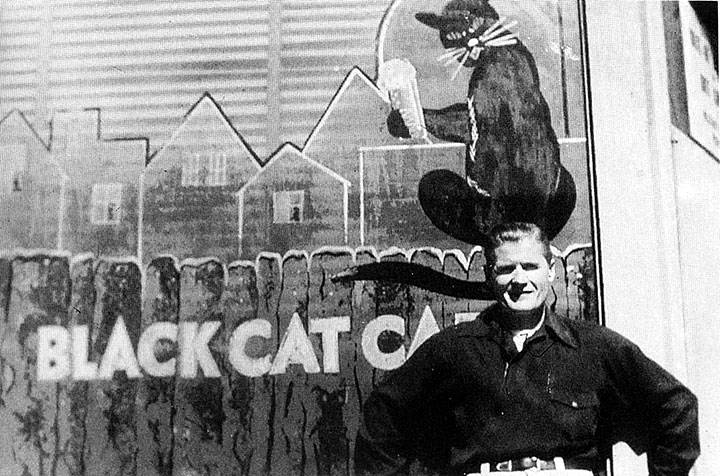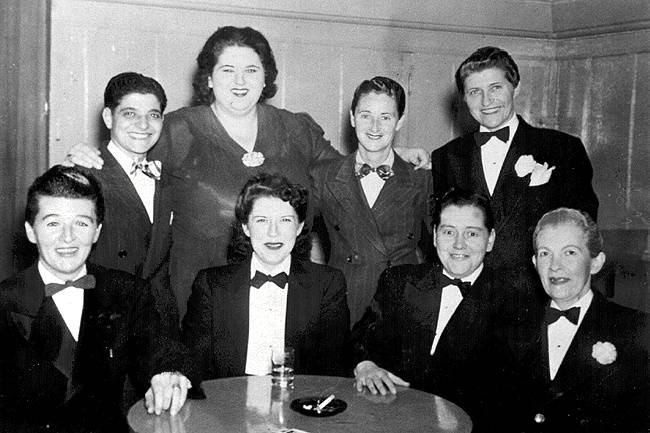Before the Castro: North Beach, a Gay Mecca
Historical Essay
by Dick Boyd Author of Broadway North Beach: The Golden Years
Originally published in The Semaphore #189, Winter 2010
Front of Mona's, 1945.
This story has been a blast from the past for me. From 1948 through the 50’s I was a habitué of North Beach. I hit many of the watering holes in this story. In 1955, I was a Grey Line Tour Guide for their Night Club tours that made stops at Finocchio’s, the Gay Nineties and La Casa Dora, all on Broadway. In 1960 I became a partner in Pierre’s Bar at 546 Broadway.
During these years I was an observer of, if not regularly a participant in, the homophobic behavior of the time. In the 40’s and 50’s and into the early 60’s, gay guys were called either “fairies,” “homos,” “fags,” or “queers.” Lesbians were called “butches” or “bull dykes.” Homophobia reigned. A post WWII “macho” culture prevailed. It was that way in high school and college in both athletics and fraternity life. In fact, the fraternity that a group of my friends and I started in 1948 at San Francisco State, “black balled” (no pun intended), some years after our departure, Johnny Mathis, not because of his race, but because of his sexual orientation. The irony here is that at our founding we had applied for a national charter but declined it after we learned of the national’s racial and religious stipulations. We called ourselves Alpha Zeta Sigma and to us that meant we welcomed everyone from A to Z. But by the mid-fifties that founding principle had been forgotten.
I was going to all kinds of places in North Beach in the late 40’s and early 50’s. I don’t recall being asked for an ID. My favorite two places were Vesuvio and 12 Adler. In the late 40’s, I was usually with the boys and the focus was on drinking and stories. In the early 50’s I began hitting Broadway for the girls. I did notice that 12 Adler was laden with Butches as well as some foxy ladies. I was running on pure testosterone, so I only focused on the foxes. I don’t recall whether on not I made a convert, but I do remember trying. I never counted how many times I struck out. I just kept stepping up to the plate.
Later at Pierre’s we had a few surprising gay experiences. Our Schlitz beer salesman said he belonged to the Mattachine Society (a gay political organization formed in the 1930’s lobbying for gay rights). My partner and I never had a clue what it was, and the guy was anything but swishy. Dave Kopay was one of the 49ers that came in on Sundays after 49er games then played at Kezar Stadium. His nickname in training camp was “Animal.” He was the first professional football player to “come out” publicly, a very courageous act at the time. Bill Paul, who was our bouncer for two years (1962 to 1964) and left to train for the US Judo team, becoming captain of the 1964 Olympic team in Tokyo, came out a few years later. He became president of the Stonewall Gay Democratic Club. He died in 1988 from a brain tumor associated with the HIV virus.
Now to the story. I have focused on five clubs that best exemplify a cross section of gay/lesbian establishments at the time.
Tommy’s Joint, 299 Broadway, 1948 to 1952, Tommy’s Place, 529 Broadway, 1952 to 1954 (Now the Garden of Eden)
Tommy Vasu was the first known lesbian to legally own a bar in San Francisco. When out on the town she dressed like a man in double-breasted suits, wide tie and a fedora hat. She used the men’s room, had a beautiful blond girlfriend and loved to gamble. In short, she was a risk taker. She often came into Pierre’s for high stakes prearranged liar’s dice games with artist/entrepreneur Walter Keane.
The 299 Broadway site was where businessmen from the nearby financial district could find a willing hooker out of sight of prying eyes at places like Paoli’s. Stevedores from the docks close by also partook of the hookers on paydays. The hookers were the girlfriends of the butches who hung out there.
Adjoining Tommy’s Place was 12 Adler (now Specs) accessible by a back staircase. It was a lesbian pick-up rendezvous. Upstairs was entertainment pretty much by whoever cared to perform. During a purge of gay bars in the early 50’s, 12 Adler lost its liquor license in what appeared to outsiders as a set-up. Drugs were found taped to the drain under the sink in the ladies room.
Tommy ran the Broadway Parking concession and was around Broadway until the mid 60’s. Tommy’s high maintenance blond was a heroin addict and Tommy became a dealer to supply her needs. She got busted and sent to Tehachapi where she was murdered shortly after her release.
Jeannie Sullivan & Tommy Vasu (far right) taken at Mona’s.
The Paper Doll, 1949 to 1961
Located on Cadell Place just off Union was a gay bar/restaurant. It was owned by New Pisa restaurant owner and North Beach baseball legend Dante Benedetti. I lived around the corner on Grant and ate there frequently. The food was excellent. You could get a steak with all the trimmings for $1.65. I could even afford to tip at those prices.
In the late 1950’s and early 60’s the Paper Doll held Halloween parties overflowing down Union and up to Grant. There was a contest held for the best costume and drag queens came from as far away as New York to compete for the crown.
Dante got busted in the same purge of gay bars as Tommy Vasu. He pursued appeals but finally lost the battle in 1961. Later the place became the Manhattan Towers, owned by Katherine James, and leaned more towards a lesbian pick-up place.
The Black Cat, 710 Montgomery, 1933 to 1963 (Now Bocadillo’s)
A Bohemian hangout located right across from “The Monkey (read Montgomery Street) Block Building,” home of Bohemian legends William Saroyan, Benny Bufano and Enrico Banducci. They, along with socialites, gays and “butches” cruising for new talent, bikers, the curious and college kids like myself looking for a cheap meal, could be seen there. On a Sunday morning you could cure a hangover with a great breakfast and a couple of Bloody Marys for under $3 bucks.
In 1949, straight Black Cat owner Sol Stouman took the issues of identifying and serving homosexuals to court (Stouman vs Reilly) and won. George Reilly was the head of the Board of Equalization (BOE), which at the time was in charge of enforcement and taxation. This was before the Alcoholic Beverage Control (ABC) and enforcement at bars and clubs was hazy at best. The SFPD was saying that the Black Cat was attracting undesirables and Stouman was being harassed and threatened with closure by the SFPD, the BOE and later the ABC. For help, Stouman formed the San Francisco Tavern Guild, which became the first gay bar association and still functions to this day. However, the reformers (SFPD and the State Legislature) were relentless in their legal efforts and eventually, after new legislation, the courts overturned the earlier ruling which forced the Black Cat to close October 30th, 1963, after a 14 year legal struggle.
James MacGuiness, pianist, Black Cat, 1965
The Beige Room, 831 Broadway, 1949 to 1958 (Now the Woo Yee Children’s Services)
Strictly gay, it featured female impersonators who were mostly gay. Unlike Finocchio’s it was not a tourist trap and gay men felt more comfortable hanging out there. Also unlike Finocchio’s, where owner Joe Finocchio forbade such socialization for fear of losing his liquor license, the openly gay performers often socialized with the customers. This often led to wild after hour parties. Many of San Francisco’s high society were to be seen there on special occasions, one of which was the Tavern Guild’s Beaux Arts Ball, which like the Halloween event at the Paper Doll, was all about the costumes featured by the drag queens. The establishment even had its own columnist Henry Diekow who called himself Baroness Von Dieckoff and called his column “Bag-a-Drag-by the Bay” mimicking Herb Caen’s column “Baghdad-by-the-Bay”.
Mona’s, 440 Broadway, 1939 to 1948
Lesbian Pick-up and Male Impersonators. Women dressed like men and entertained customers. Mona Sargent and then husband Jimmie started the biz right after the repeal of Prohibition at 451 Union Street (1933 to 1935), on the corner of Varennes, between Grant and Kearny (now the Diamond Nail Waxing). In 1936 they moved to 140 Columbus (now the Purple Onion). In 1939 they moved to 440 Broadway. It was actually opened by Charlie Murray as the “440” but he soon brought in Mona as a partner and it became “Mona’s 440.” Often men had to front for lesbians in bars and clubs in order to get the approval of the Board of Equalization for their liquor license. Mona’s flourished during WWII and the Korean War. It was a favorite with lesbians but even with servicemen as it was not “off-limits.” Tourist loved it for its entertainment but also knew they might be able to connect with someone of the same sex which could not happen back home.
Male Impersonators at Mona's in North Beach, circa 1945. Standing (l to r): "Butch," Jan Jansen, Kay Scott, Jimmy Renard. Seated: (l to r): "Mike," Beverly Shaw, unidentified, "Mickey".
Photo: Gay and Lesbian Historical Society of Northern California
It became Ann’s 440 Club in the mid fifties run by Ann Dee. Johnny Mathis sang there under the tutelage of Ann who helped him with his stage presence. Lenny Bruce appeared there when his act was more New York Jewish humor than the anger he later fell into in his performances. Ann gave a lot of aspiring performers a chance to get on stage and worked with and helped train them.
Looking back from a perspective of close to 50 years, it’s easy to see how the mix of artsy bohemianism, tolerance and low rents made for an environment that allowed the gay lifestyle to prosper. All these ingredients are still in place in our neighborhood—except for maybe the low rents.
Other Gay and Lesbian Establishments
Artists Club—345 Pacific Ave, 1946–1949: Now a parking lot. Lesbian pick-up place.
The Anxious Asp—528 Green Street—Bohemian/Lesbian, 1958–1967: Opened and owned by Arlene Arbuckle
Blanco’s Tavern—905 Kearny St., (Manilatown) Female impersonators, mostly gay Filipino men, and pick-up place, 1943 to mid 1950’s: Run by Kay Blanco (half Filipino and Caucasian and a lesbian)—owned by her father. It is now the “Grassland Cocktail Lounge.”
The Chi Chi—467 Broadway, Night Club, 1949–1956: Gay & Lesbian friendly, owned by Andy and Ted Marefos. Eventually became the Pink Elephant and then by 1966 became the Club Fuji.
The Capri aka The Kiwi—1326 Grant Avenue, Lesbian bar, pick-up place, 1964–1972. Now the Royale North Beach Bar.
Cargo West—1105 Battery, Restaurant/Night Club, 1968–1976: Ironically now “Retail West,” a commercial real estate business. They had never heard of the Cargo West.
The Colony Club—711 Pacific, 1965–1976: Lesbian, now the Ping Yuen Tenants Association, a San Francisco Housing Authority project for Chinese.
Copper Lantern—1335 Grant Ave, 1955–1965: Lesbian, opened by Lisa and Mike, two former Paper Doll waitresses. It somehow survived the anti-gay purge of the Christopher regime and in the 60’s they tried Go Go dancers for a while. In 1966 it became the “Crown Room” for an undetermined period. This location is now “Chong’s Barber and Beauty Shop.”
Jackson’s—2237 Powell Street (Next to Caesars Restaurant), Male Bar/Restaurant, 1961–1976: A neighbor told me when they moved out he counted 28 mattresses being tossed out of the second floor window.
Katie’s Opera Bar—1441 Grant Ave., Bar, 1965–1976: Now the Blue Sparrow Pilates.
La Vie Parisian—574 Pacific, bar/nightclub, Female Impersonators, 1947–1950.
Mary’s Tower—1500 Grant corner of Union—Lesbian bar/restaurant—1953 to 1967. Now the Mea Cines Ancient and Modern Artifacts.
Miss Smith’s Tea Room—1353 Grant Ave., 1954–1960, Lesbian pick-up place: Now “Maggie McGarry’s,” the owner was Connie Smith, a former Artists Club waitress.
Mona’s Candle Light Room—473 Broadway, 1948–1957, Lesbian: owned by Mona Sargent (formerly of Mona’s) with partner Wilma Swarts. Later it became the Club Gala owned by Pete Marino, local Galileo HS boy. Later this location housed the Jazz Workshop, Burp Hollow and the Dixie Land Jazz. These Clubs all “morphed” between 473 and 477 where the Bamboo Hut is located today.
The Tin Angel—981 Embarcadero, Restaurant/Night Club, Lesbian, 1953–circa 1962: originally opened and owned by amazingly talented artist/poet/raconteur/entrepreneur Peggy Tolk-Watkins. Peggy, who crossed the gender lines (bi-sexual), later opened up the Fallen Angel with Sally Stanford at 1144 Pine Street, Sally’s old high end House of Prostitution. Peggy hit the Bay Area like a comet but flamed out in 1973 at the age of 51 after living life full speed.




